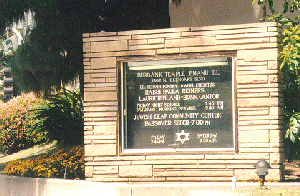 You may have noticed when entering homes where Jewish people live a little mark on the outside frame of the front door. If you are Jewish, you should also have this mark which is called a ‘mezuzah’.
You may have noticed when entering homes where Jewish people live a little mark on the outside frame of the front door. If you are Jewish, you should also have this mark which is called a ‘mezuzah’.
What Is A Mezuzah?
A Mezuzah has been used over many generations and is one of the symbols of a Jewish home. A piece of hide from a kosher animal known as a ‘parchment’ has the Shema Prayer and the paragraph, Vehaya, “and it will be” written on it by a Jewish Sofer, (scribe). It is written with a quill – feather with a hole at the end dipped into ink.
A Scribe Writes The Mezuzahs
![]() The mezuzah is written by a scribe who has been specially trained to write holy items including Sefer Torahs, Megillahs as well as Mezzuzahs. A person wishing to become a scribe has to be tested by a Rabbi to determine if he is qualified. Among some of the requirements is that he has to be right-handed and be considered as someone who is a ‘Baal Yireh Shamayim’ – One who fears G-d.
The mezuzah is written by a scribe who has been specially trained to write holy items including Sefer Torahs, Megillahs as well as Mezzuzahs. A person wishing to become a scribe has to be tested by a Rabbi to determine if he is qualified. Among some of the requirements is that he has to be right-handed and be considered as someone who is a ‘Baal Yireh Shamayim’ – One who fears G-d.
If he is accepted for training, he learns how to write the letters properly following laws on how it should be written. When he has mastered the skill, he writes a Megillat Esther – The Story of Esther. Everything that he writes is checked and rechecked although today there are special computers that can check a scroll for mistakes more accurately.
Getting A Proper Mezuzah
The parchment is put inside a case, a box-like’ container that is then attached to the door frame. You need to be sure that you get a proper mezuzah, as in today’s world, many non-Kosher Mezuzahs are being made and sold.
One is not allowed to print these two prayers by machine. A Mezuzah has to be checked twice in seven years. If there are any cracks in the letters, then it must be fixed or a new one has to be put in its place. If there are any holes or letters missing, then it can’t be fixed or used any longer. One puts these unfit holy writings into a Geniza, a storage place for holy writings until it can be buried in a special way.
 The Mezuzah is usually protected by putting it in a case or wrapping it very carefully in plastic. The case is made with a ‘Shin’ facing outwards. There are many laws involved with writing a Mezuzah. One requirement is that it must be written in order. No word or letter is allowed to be missing or higher or lower than the rest of the letters in the line. If there are any mistakes, it is considered UPossul”, unfit and can’t be used.
The Mezuzah is usually protected by putting it in a case or wrapping it very carefully in plastic. The case is made with a ‘Shin’ facing outwards. There are many laws involved with writing a Mezuzah. One requirement is that it must be written in order. No word or letter is allowed to be missing or higher or lower than the rest of the letters in the line. If there are any mistakes, it is considered UPossul”, unfit and can’t be used.
The Mezuzah has the letters ‘Shin and Daled and Yud’ written on it spelling out one of G-d’s names facing the outside. This piece is rolled up very carefully so that the Name will show and can’t be put upside down in the case.
The Shema Prayer
 The Shema Prayer affirms our belief in G-d, as one G-d and that there is none besides Him. The Mezuzah shows that this home is a Jewish one. G-d promised us that He will protect us and the Mezuzah is a sign of His protection.
The Shema Prayer affirms our belief in G-d, as one G-d and that there is none besides Him. The Mezuzah shows that this home is a Jewish one. G-d promised us that He will protect us and the Mezuzah is a sign of His protection.
When the Jewish people were still in Egypt, they were told by G-d (through Moses) to smear blood on their doorposts as a sign of being a Jewish home. That was before the Angel of Death, in imposing the tenth plague, passes the Jewish homes and smote all of the first-born sons of the Egyptians.
Where To Put It
A Mezuzah is put only in a permanent dwelling. If someone is living in a place temporarily, they do not have to put up a Mezuzah. That means a place like a Succah would not need a Mezuzah.
If someone is moving from one place to another and they know that the new people moving in are Jewish, they are not allowed to remove the Mezuzah. If they do not know who is moving in, or if they are non-Jews, then they are allowed to take the Mezuzah off. In Israel, people put up a Mezuzah immediately but outside the land of Israel, you have up to 30 days to put one up since it is not considered a permanent dwelling place.
The Mezuzah is placed on the right side of the door in most cases on the upper third of the doorpost height (shoulder height) with the top slightly slanted to the inside of the room. It has to be put on all the doors of the house and garages that one uses except for the facilities or a room that is less than 4 cubits wide. Whenever in doubt of whether to put it on the left side or right side of the door, consult with a Rabbi.
A blessing is said when a new Mezuzah is put up… Asher kidshonu bimitzvotav v’tzivonu likboa Mezuzah… Who has sanctified us with His commandments and commanded us to affix (put up) a Mezuzah.
You would usually kiss the Mezuzah when entering or leaving the room or house. The larger the Mezuzah is, the better it is because the writing is larger which makes it easier to catch mistakes or problems and to correct it if it is possible.
Stories Of Being Protected
There are many stories that have been told of how the Mezuzah protects a Jewish person. One of them, from Miracles and Wonders by Kehot Publications, is a story of a person with a heart condition. The person was checked by a doctor and was told that he was in very serious condition and that he should have an operation. The man wrote a letter to the Rebbe of Chabad and asked for a blessing for a complete recovery and advice about what to do with this condition. The Rebbe responded that he should check his Mezuzahs. He had his Mezuzahs checked and there was a letter missing in the word “Levavcha”, meaning your heart. The man replaced his Mezuzah and then went for another check up soon afterwards. The doctors found nothing wrong.
Another story is of a couple who were married for many years and didn’t have children. They tried various doctors and methods with no success. Finally, they were advised to write to the Rebbe of Chabad. They did, and he told them to check their Mezuzahs. They found that the word “Rechem, ” womb was missing. They replaced the Mezuzah and very soon afterwards, they had their first child.





